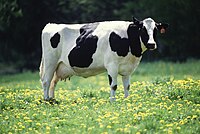
Photo from wikipedia
Removal of cows from dairy cattle production is a routine and unavoidable practice of the dairy industry and is often referred to as culling. The objectives of this study were… Click to show full abstract
Removal of cows from dairy cattle production is a routine and unavoidable practice of the dairy industry and is often referred to as culling. The objectives of this study were to use a survey to describe current on-farm cull cow management, farmers' perception of cull cows' journeys to slaughter, and the adoption of current recommendations and regulations by Ontario dairy farmers. All Ontario dairy farmers were invited to complete a cull cow management survey between December 2020 and March 2021 that included 44 questions covering farmer demographic information, farm characteristics, and cull cow management. The survey response rate was 7.4% (n = 248); a total of 226 of the responses were included in this study for analysis. Most respondents indicated they have a written standard operating procedure (SOP) for cull cows (62%), and 48, 13, and 15% of those identified they use their cull cow SOP “always,” “sometimes,” and “never,” respectively. The more confident respondents were that cull cows arrived at slaughter in the condition they left the farm the less likely they were to have a cull cow SOP [odds ratio (OR) 0.83]. The most important sources of information for the management of cull cows were the herd veterinarian (64%) and members of the marketing/regulatory organization the Dairy Farmers of Ontario (44%). Drug withdrawal time was the only factor most respondents (73%) considered “very important” for the assessment of cull cows prior to transport. Most farmers believe cull cows journey from the farm to slaughter is three or less days (55%), and the confidence of farmers that cull cows arrive at slaughter in the condition they left their farm was generally high. Lastly, most farmers (66%) identified they were familiar with recent regulatory changes around the fitness, duration of transport, and lactation status for cull cows. These results highlight farmers' perceptions of the impacts and durations of the journey of cull cows differs from reality, and there are misunderstandings of the requirements for cull cow management. Further research should investigate how different strategies for training farmers may lead to improved cull cow welfare and regulatory compliance.
Journal Title: Frontiers in Veterinary Science
Year Published: 2022
Link to full text (if available)
Share on Social Media: Sign Up to like & get
recommendations!